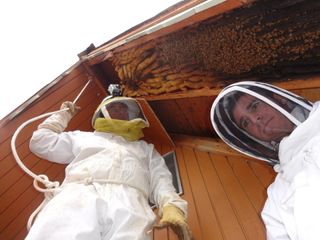Huge 12-Foot Beehive Creates a Big Buzz

Utah is known as the "Beehive State," a name originally intended as a tribute to the industrious nature of Utahans.
But the state now has another reason to claim its nickname: In April, beekeepers removed a gargantuan beehive measuring 12 feet (3.6 meters) in length from a cabin in Eden, Utah.
"It was amazing," said apiarist Vic Bachman of Ogden, who removed the honeybee hive with the help of his partner Nate Hall, according to Fox 13 News. "It was just incredible to see how big it was."
"We figure we got 15 pounds (6.8 kilograms) of bees out of there," Bachman told The Associated Press, adding that the hive's weight converts to about 60,000 honeybees.
Though this might not be the world's largest beehive — no official records are kept — Bachman said, "I haven't seen one that huge."
In the wild, honeybee hives are found in hollow trees, rock crevices and other secure, dry areas, usually with a single entrance. The hive's honeycombs are made of a wax secreted by the worker bees' wax glands.
The massive Utah hive was hidden beneath the cabin's eaves since 1996. Since it was rarely occupied, the cabin's owners didn't consider the hive to be a problem until they started using the building more regularly.
Sign up for the Live Science daily newsletter now
Get the world’s most fascinating discoveries delivered straight to your inbox.
The total size of the hive was 12 feet (3.6 meters) long, 4 feet (1.2 meters) wide and 16 inches (41 centimeters) deep, according to the AP. The cabin's owners decided not to kill the honeybees because the insects are an increasingly valuable commodity.
Not only do bees pollinate about one-third of crops worldwide, their numbers are increasingly threatened by colony collapse disorder, a serious condition that's wiping out bee populations across Europe and North America.
To stem the losses of bees, the European Union has voted to ban neonicotinoid pesticides — a class of pesticides linked to colony collapse disorder — by July 1 of this year.
Bachman removed the bees with a vacuum, then transported them to his house for Deseret Hive Supply, his thriving home business.
"We caught the queen and were able to keep her," Bachman told the AP. "The hive is in my backyard right now and is doing well."
Follow Marc Lallanilla on Twitter and Google+. Follow us @livescience, Facebook & Google+. Original article on LiveScience.com.

